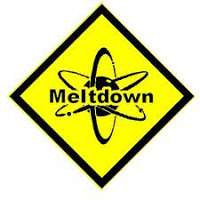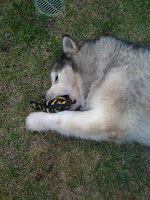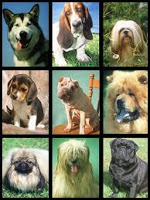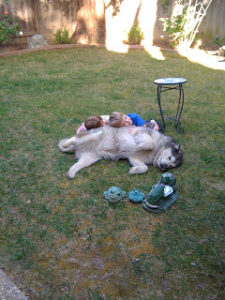There are several items that are used in training dogs: leashes, collars, harnesses, treats, clickers, and depending on what you’re training, toys etc. But right now I’m focusing on collars. Specifically correction collars and harnesses.
The reason behind this being, I have recently seen a number of dogs living in collars that are supposed to be used for training purposes. And the opposite – where a correction collar is needed; then not used because it’s misunderstood.
They all have their purpose and place. Often, in most cases, a correction collar isn’t needed. Just a little patience, training and consistency can correct unwanted behaviors. Always start small, then work your way up!
I’ll break these down into 3 categories – With Pictures! 😀
- Everyday Wear
- Correction Collars
- Harnesses
Everyday Wear:
1.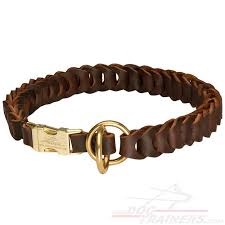 2.
2. 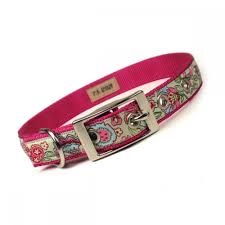
3. 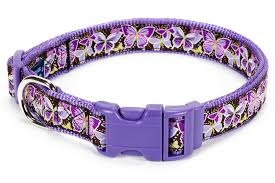 4.
4. 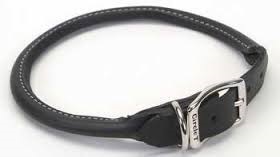
#1- Braided Leather Collar: As with all leather products, the more you use it, the softer it becomes. The one shown above has what’s called a “quick release” clip, which makes it easy to take off in a pinch. Also, easy to snap onto your dog too, if you’re the type that likes to let them “go naked” at night.
#2- Flat Buckle Collar: These collars are less likely to snap apart in a pinch, but this style comes in so many different colors and patterns (as do the quick release buckles) so you can have more of a “personality” showing with these.
#3- Flat Quick Release Buckle: Again, just like 2, you can find all kinds of colors or patterns, which makes these fun.
#4- Rolled Leather Collar: I prefer these for my dogs, when we need to leave the house. I have always had really fluffy dogs with double coats, and when you put a flat collar on a double-coated dog, it tends to mat the hair underneath and flatten the coat. With a Rolled Leather collar you completely avoid that. They do come in different colors now, but no patterns. You wouldn’t be able to see it in the Malamute’s coat, anyhow 😉
When it comes to “everyday wear”, you want your dog to feel comfortable. Just like how you enjoy wearing sweats at the end of the day. Your dog likes to have it’s comfy “clothes” on, too. These are collars that you leave on your dog. They are also the ones that you attach their information tags to. So always be sure to have them on your dogs when you aren’t home. As well as every time you go out with your dog.
When fitting your dog with a collar, you want it to be tight enough that it wont slide off, over their ears, should they pull away from your grip on it. But loose enough that you can stick about 2-3 fingers in there between the neck & collar. We don’t want doggy to feel strangled, but you want to be able to keep control with it, should the need arise.
All 4 of these collars above are good “everyday wear” for your pups.
Correction Collars:
1.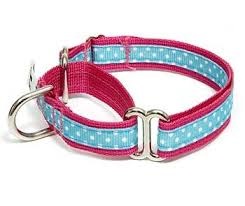 2.
2. 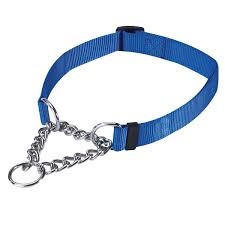
3. 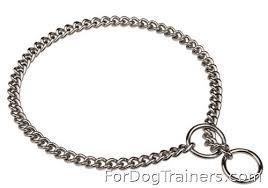 4.
4. 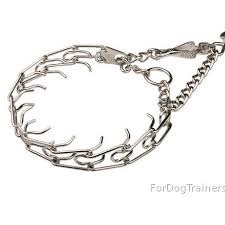
#1- Flat Martingale: This collar is designed to resemble the regular “everyday” flat collar. With a bit of a “correction collar” thrown in. A Hybrid, if you will. This is the only one of these four I would be OK with any of my dogs living in. It’s just like a regular flat collar, has a space for the ID Tags, and is also designed to tighten on the dog when it pulls – if you attach the leash on the top ring.
#2- Martingale Collar: This is the first design of the martingale collar. Where they combined the chain collar with the flat. It works in much the same way as #1 does. It tightens when being pulled on, and has a stopping point so that it doesn’t continue to choke your dog. With both of these collars, they CAN be ineffective if left too big. The idea is that it should tighten enough to be uncomfortable, but not so much that the two “stopping rings” touch. I often see these two collars living on dogs, and they are way to big so that when the dog pulls the rings are touching and there is still space between the dog’s neck & the collar. If you are going to have them that way, just put on a regular flat or buckle collar because it’s pretty much the same thing. The “stopping point” of these two collars should stop at your dog’s neck, and still have some space before the rings are touching each other. That’s the truly effective way of using them.
#3- Choke Chain: That’s the traditional name, but Chain Collar works just fine. Or Slip Chain. The “clip” ring (the piece hanging out at the bottom) is where you clip your leash. the “active” ring is what slides closer or further away from your dogs neck. If you are interested in using one of these collars – I HIGHLY suggest getting a professional to help fit your dog with one. There are specific grades of chain (small, medium, heavy, extra heavy, extra small), as well as different lengths.
If it’s too long, it’ll be ineffective. If it’s too short, it’ll be ineffective, and really uncomfortable and potentially dangerous for your dog. It needs to be a perfect fit for your specific dog. Basically, when you slip this on over their head, and pull it all the way out (meaning the active ring is sitting against your dog’s neck) you want to have about 6 inches of chain out. Because the idea of this collar is that the dog listens to the ring sliding on the chain, when you tighten it. Thus teaching your dog to listen to the ring sliding, later on, rather than “getting choked”. Proper technique, and placement on the dog, is everything with this collar, and I DO NOT recommend using one unless you know what you are doing, or you have a professional trainer show you how to use it. This collar is misused about 95% of the time. From the way it’s put on, to it’s size and thickness of the chain. All-in-all, if you feel like your dog needs to ‘graduate’ to this type of collar, PLEASE get some training help before you put one on!
#4- Prong Collar: Ah! It’s a Torture Device! “Doesn’t that hurt the dog?!” Well, yes, it CAN – if you are using it wrong. Again, this is another collar I suggest you ONLY use, if you are being directed by a professional trainer. This is a HIGHLY effective collar for BIG dogs who like to pull. Bully Breeds, Northern Breeds, etc. The ONLY people who should be using this collar, are the ones who have dogs that pull. Big dogs can easily knock their people down when going for a walk if they pull hard enough and catch you off guard. If there is any sort of physical limitation such as a person who doesn’t have much strength, anyone healing from some kind of surgery that affects your walking/stability/balance/strength, younger adults/teens with big dogs, etc. I highly recommend using this collar.
It is what I always refer to as “Power Steering”.
It is designed to resemble Momma dog’s mouth. When the dog pulls, the “teeth” of the collar tighten around the dog’s neck. When doggy feels that sensation they are automatically reminded of when their mom would correct them for something they did wrong, in the whelping box, and will correct whatever behavior is happening right then.
When used the right way, it can be a VERY effective tool at keeping your dog under control. I NEVER yank on the leash hard to “pop” them with it. It takes just a very small correction using your hand and a slight wrist motion, to get the point across. If this collar is too big, it’ll be ineffective. If this collar is too small – it can cause serious damage to your dog’s neck. Again, if you think you might need this collar to help you on your walks – PLEASE consult a professional to show you how to use it the right way.
NOTE: NEVER leave this on your dog 24/7. For one, they shouldn’t be living in metal, anyway, but for all the reasons stated above – it can be dangerous or become completely ineffective.
Correction collars are named for that purpose. Correcting unwanted behaviors. These four collars are used for training only. They are not to be used as everyday living situation collars. (Number 1 being the only exception to the rule).
In my profession, I have seen so many dogs live in collars 3 & 4. This is a pet peeve of mine, and can be potentially very dangerous. There are all kinds of things that can go wrong with them. They can get caught on something, and because of their design, can choke or severely injure your dog. All four of these collars are designed to tighten when they are pulled at the ring. If your dog gets stuck on something and you aren’t around, it can panic and hurt itself pretty bad with any one of these. It’s just not safe for them.
But, the other reason is this. Dogs also become immune to them. They are for training purposes only. But if they are left on 24/7 your dog will learn to ignore it, and it won’t mean anything to them, anymore. Rendering your training tool completely useless. A dog living in a choke or a prong collar is used to the feel of it around their neck, and when they are wearing it while just hanging out on the couch, or rummaging through the backyard they are having all kinds of other experiences with them, that isn’t “correcting” any type of behavior. So, then a dog that pulls, will continue to pull because it feels the same sensation all day long, doing a million other things on it’s own. Use them for walks & training. Take them off when you are lounging or crating. And NEVER leave them on when playing with other dogs!
Harnesses
1.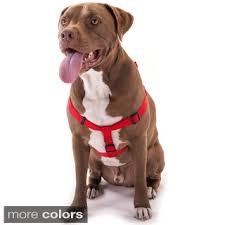 2.
2. 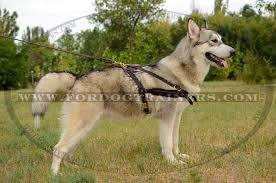
3. 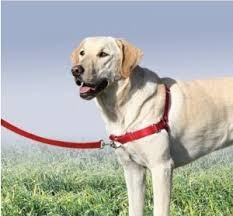 4.
4. 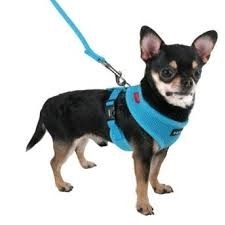
#1- Traditional Harness: This is your basic harness. They go over the head and through the paw and the leash clips on the back. This is a good one to use for riding in the car – clip the seat belt through the hand loop of a tab leash, then clip the leash to the back of the harness. This type of harness will encourage a dog to pull. It feels good because it lies across their muscles, and the more they lean into it, the more they want to. Not the greatest for training a dog to walk nicely next to you.
#2- Pulling Harness: This is usually used on Malamutes and Huskies for pulling competitions or sleds/carts. There are several points on it to distribute the weight evenly throughout the dog, while supporting it at the same time. Again, it feels good on them to pull in it, that’s what it’s designed for – Not training a dog to walk nicely next to you. 😉
#3- Front Clip Harness: This is a nice harness that clips in the front. It is designed with the “gentle leader” in mind, where, when the dog pulls ahead – it encourages them to turn toward you and slow down. It doesn’t necessarily work that exact way, but I do like walking the bigger dogs in this harness, I have more control over them. However, if you have a very rowdy dog that’s persistent enough – they CAN pull out of this. I’ve had it happen. So, depending on your situation, this can be a good harness to use (easy-going, trainable dog, not too into pulling or lunging), or maybe you should consider a collar. 😉 Out of all 4 of these harnesses, for large breed dogs – this is the one I prefer!
#4- Soft Shirt Harness: I believe they only make this harness for small to medium dogs. And that’s just fine – that’s the only dog I would suggest putting in these. It’s comfortable on them, there are no points where the harness straps can dig into the doggy’s arms or sides. It clips in the back which is convenient for the smaller dogs. I prefer walking any small dog in this – or harness #1 – instead of collars. Small breed dogs aren’t strong enough to pull you into the street, but you are strong enough to accidentally hurt them, n the wrong type of collar. So, as a universal rule, for me, I like putting all small dogs in this type of harness for walking or training.
And – Just like correction collars – always remove the harness when you get home! Dogs shouldn’t live in a harness, either. It’s uncomfortable to wear for long periods of time, and can cause skin and hair loss issues.
What’s a Tab Leash?
You probably thought I’d forget – nope! I mentioned it, so here it is.
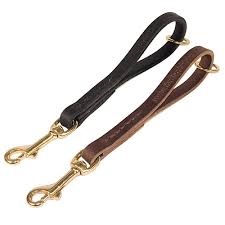
These are Tab Leashes. It’s a very short leash with just a handle on it. These are some of my favorite leashes, personally, because I always have REALLY big dogs (Shown Below is an example of me with my King Shepherd Tobi). I also like using these for seat belts. However – when I am training dogs, I always recommend a 6ft. leather leash for all my clients. Leather – the more you use it, the softer it gets. When in training you will always need more length. But I do recommend these paired with a harness, for seat belts in the car!
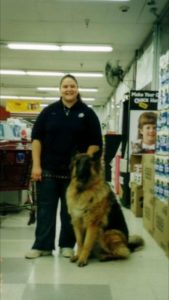
That’s usually why I don’t need long leashes 😉
Me & Good Ole Tobi
(10/2000 – 05/2011)

